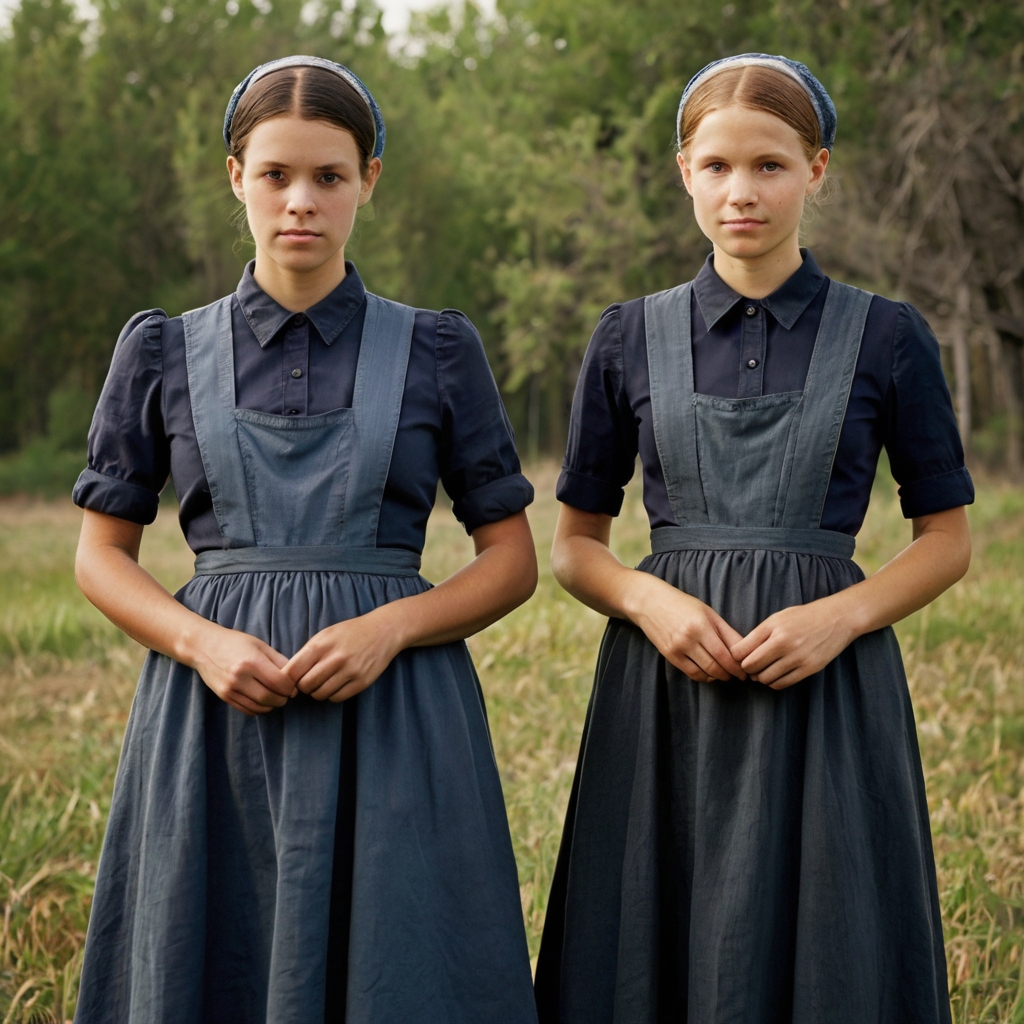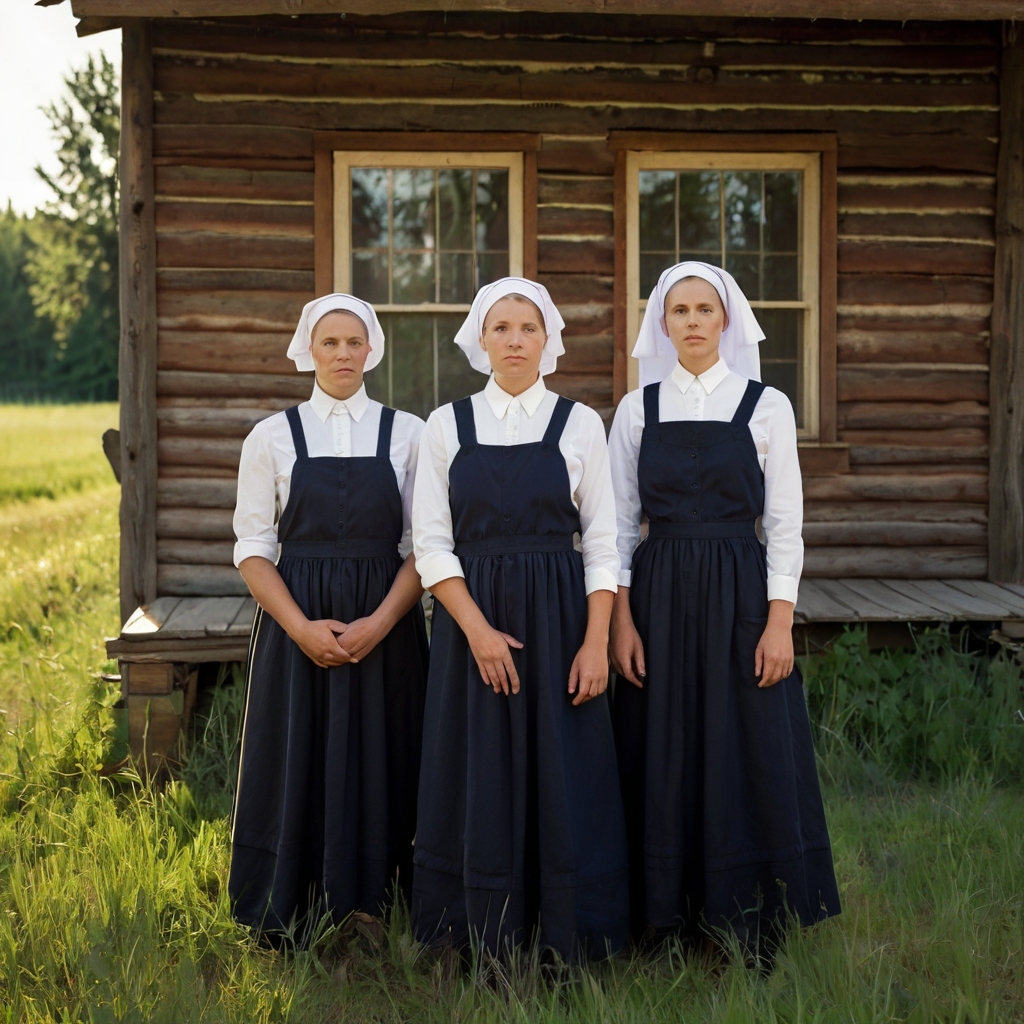Mennonite women’s distinctive style sets them apart from today’s fashion-driven world through their emphasis on modesty, simplicity, and community values. Their unique clothing traditions differ from the Amish, especially when you have their prayer caps or scarves that serve as defining features.
The dress code varies among different Mennonite communities. Modern Mennonite women enjoy more flexible clothing choices while maintaining modest dress standards. This diversity becomes apparent in newer Mennonite communities. Hispanic, African American, and Asian members now make up 20-25 percent of the membership. Traditional practitioners maintain core modesty practices. They wear head coverings during daily activities and choose skirts or dresses instead of pants. Modest clothing serves as a visible marker of Plain groups, including Mennonites. Their appearance reflects their belief of being citizens of “Two Kingdoms”.

The Core Values Behind Mennonite Women’s Dress
The distinctive attire of Mennonite women shows their deep spiritual convictions rather than just following religious rules. Mennonites have shaped their clothing practices over time to show their core values and theological understanding.
Modesty as a spiritual principle
Modesty means much more than clothing choices in Mennonite communities. “Modesty is not just about the clothes we wear but a reflection of our inner values and beliefs”, explains one practitioner. This principle comes straight from biblical teachings, especially passages like 1 Timothy 2:9-10, which encourages women to “adorn themselves in modest apparel, with shamefacedness and sobriety”.
Mennonite women’s modest dress puts inner beauty ahead of outward looks. “Biblical teaching calls women to put a greater value on what is inside of us than on our appearance”, says one Mennonite woman. This belief mirrors the biblical passage in 1 Peter 3:3-4, which values “the hidden man of the heart” over “outward adorning”.
These beliefs shape daily life. Many Mennonite women see modest dress as proof of their worth beyond physical appearance. “Dressing simply is a way of saying and of feeling deep within myself that I am worth more than my clothes or my sex appeal”, one woman explains.
Simplicity and humility in daily life
Simplicity is the life-blood of Mennonite women’s dress. Conservative Mennonite communities choose plain, functional clothing that shows their steadfast dedication to humility and rejection of materialism. This simplicity shows up in several ways:
- Solid colors or small prints instead of flashy patterns
- No makeup and jewelry
- Simple hairstyles, often in tidy buns
- Practical, long-lasting garments instead of fashionable ones
These choices demonstrate the community’s focus on stewardship and careful use of resources. They also remind Mennonites daily about living “free from vanity and excess”. Cape dresses are practical too. One woman points out they’re “the easiest way to dress tastefully, economically and modestly without going to a lot of trouble”.
Separation from worldly fashion
The third key principle of Mennonite dress code is staying separate from worldly influences. Romans 12:2 shapes this belief, telling believers to “be not conformed to this world”. Mennonites use their unique clothing to create clear boundaries between themselves and mainstream society.
This separation became more formal in the late 1800s. Early Mennonite communities focused on simple clothing rather than strict uniformity. All the same, Mennonite churches passed at least 230 resolutions about nonconformity in dress between 1865 and 1950.
The Mennonite women’s head covering stands out as their most visible symbol. Prayer caps, bonnets, or veils follow 1 Corinthians 11’s teaching about women covering their heads during prayer and worship. These distinctive coverings help strengthen community identity too.
Modern Mennonite women think carefully about these traditions. Research shows they don’t just follow blindly. A study of conservative Mennonite women found each person “self-identified as a practitioner of modest dress” and shared “two core modesty practices: each wore a head covering or prayer veil during daily life and each wore skirts or dresses to the exclusion of pants or trousers”. Their stories show thoughtful choice rather than blind following.

Key Elements of Traditional Mennonite Attire
Traditional Mennonite clothing combines practicality with religious symbolism. Mennonite women show their devotion to modesty through well-designed garments that work perfectly for daily life. Their unique dress has grown into a system where several elements come together to meet both practical needs and spiritual requirements.
Long skirts and cape dresses
The cape dress is the life-blood of traditional mennonite women dress. This unique garment has a double layer of fabric that covers the bodice area and creates a square or V-shaped form to minimize the female silhouette. These dresses do more than cover the body – they represent a woman’s submission to God and her acceptance of biblical gender roles.
Cape dresses give wearers both modesty and freedom of movement. The skirts reach below the knee or down to the ankle, based on what their specific denomination requires. This design lets mennonite women move easily while they work.
Mennonite women often make these garments themselves and create individual-specific versions that follow community standards. One wearer says, “They’re so comfortable!”. This shows how these dresses work well for both practical and religious purposes. Some non-Mennonites have started wearing this style because it’s modest and practical.
Plain fabrics and muted colors
Fabric choice is a vital part of what do mennonite women wear. Traditional mennonite attire uses simple textiles without fancy patterns or decorations. Some churches value plainer dresses more highly.
Traditional mennonite women choose muted, neutral colors. This shows their steadfast dedication to simplicity and separation from modern fashion. All the same, conservative Mennonites use small prints in their mennonites clothing, which makes them different from Amish communities that prefer solid colors only.
Modern features like zippers show how mennonite dress code balances old and new. Their clothing choices reflect a well-thought-out approach to daily life. They skip unnecessary decoration but use practical elements that serve real needs.
The role of aprons and layers
Aprons mean something special in mennonite women’s dress, serving both practical and cultural needs. Blue indigo-dyed aprons with special patterns have become important cultural symbols in certain Mennonite communities.
These indigo aprons use a resist-dye process called Blaudruck (German for “blue-print”). They help modern Mennonites stay connected to their history. The Kauffman Museum at Bethel College started the Indigo Textile Project to study these special aprons that Mennonite women immigrants brought with them in 1874.
Layering is everything in mennonite clothing rules. Multiple pieces work together to keep modesty in different positions and activities. Menonite women wear modest undergarments under their dresses, including plain-colored slips and bloomers. Modern Mennonite women also wear leggings under skirts “just for modesty purposes and different positions”.
This layering shows how the community thinks about modern mennonite clothing. They focus on practical solutions that keep traditional values strong. Each part of traditional Mennonite clothing serves many purposes. It gives practical coverage, shows religious commitment, connects women to their heritage, and offers a different choice from mainstream fashion’s focus on showing the body.
The Meaning of the Mennonite Head Covering
The head covering stands out as one of the most meaningful elements of mennonite women attire. This small yet powerful symbol represents more than just tradition – it carries deep religious meaning through biblical interpretation, community identity, and spiritual practice.
Biblical roots of the prayer covering
The scriptural foundation for the mennonite women head covering comes from 1 Corinthians 11:1-16. Paul’s teachings here address head coverings during prayer and worship. The passage states that “every woman praying or prophesying with her head unveiled dishonoreth her head”. Research shows Mennonite women wore head coverings from 1525 until 1866 simply because it was common in Europe. The practice became formalized through scripture only after Protestant women started abandoning this tradition.
Richard Detweiler’s Princeton study shows four distinct phases in this practice: 1525-1865 (a cultural custom with no religious meaning), 1866-1910 (scripture-based practice), 1910-1950 (established religious symbol), and 1950-present (declining adherence).
Different styles of veils and caps
Mennonite attire features various head covering styles. The traditional “haube” – German for “cap” – remains central to their dress. Some communities call it “kapp” (from German “Kappe”), which should “cover most of the hair”.
Mennonite clothing rules allow several options:
- Black or white veils made from thin lace or cloth
- Small black fabric caps of similar material
- Kerchiefs (common among Russian Mennonites)
- White coverings for single women and black ones for married women
The kapp’s front section is called the “fedderdale,” and its back section is the “hinnerdale”. Women often put bonnets over their prayer coverings during cold weather.
Symbolism of submission and reverence
The head covering in mennonite women’s dress code represents several spiritual concepts. Many ministers teach that it shows women’s acceptance of “the headship of man” and their submission to “God’s order”. One minister puts it this way: “The Christian woman’s head covering is a special item with a specific meaning – that of submission to God’s order”.
The symbolic meaning runs deeper. Some see it as a “glory veil” because woman represents man’s glory, and her hair symbolizes her own glory. The covering shows that “before God, human glory should be veiled”. Others believe it represents “power on her head because of the angels”.
Mennonite women view their covering as:
- A symbol of submission and reverence to God
- A reminder of their identity as God’s children
- Protection through appropriate “signals to the angels”
- A sign that human glory yields to God’s glory
Each community interprets these meanings differently. The words of one woman capture this personal connection: “I like to think of my dress corresponding with what is coming from my heart”. Her statement shows how this external symbol reflects deep spiritual conviction.
How Mennonite Dress Differs from Amish Clothing
Amish and Mennonite communities share similar cultural and religious heritage, yet their clothing traditions have evolved to reflect different approaches to faith and community life. The differences between mennonite women dress and Amish attire showcase their unique theological interpretations and cultural adaptations.
Similarities in modesty and simplicity
Amish and mennonite women share clothing styles that emphasize modesty, simplicity, and humility. They choose practical attire over mainstream fashion trends and avoid highlighting individual expression. Women from both groups skip jewelry and makeup because they value inner character more than outward appearance. Their traditions also require head coverings, though the styles differ between communities.
Differences in fabric, color, and cut
Mennonite women dress stands apart from the Amish’s plain clothing in several ways:
- They use brighter, more varied colors instead of the Amish’s muted tones
- Their fabrics include prints and plaids, unlike the Amish who stick to solid colors
- They prefer lighter materials, while the Amish choose heavier wool or denim
Mennonite dress code lets people express themselves more through their clothing choices. Their mennonite attire includes zippers and buttons, but many Amish communities avoid buttons as decoration. The head covering helps identify each group—mennonite women head covering looks much smaller than the Amish prayer cap or bonnet.
Modern Mennonite vs Old Order Amish
Mennonite clothing rules change a lot between different communities. Old Order Amish keep their dress code mostly the same, but modern mennonite clothing shows much more variety. Many Mennonites wear contemporary styles while staying true to modest principles.
Conservative mennonite women’s dress looks like Amish clothing but uses more colors and patterns. Progressive mennonites clothing might look just like regular fashion. This creates a range of styles—from Old Order Mennonites who look similar to the Amish to modern Mennonites who blend in with everyone else.
The biggest difference lies in how each group approaches uniformity. Amish communities value conformity, and no one wants to stand out. Even traditional menonite women can show their personality through clothing while honoring their community’s values.
Modern Adaptations and Evolving Dress Codes
The rise of mennonite women dress practices shows how tradition and adaptation work together. Mennonite attire has changed a lot through the decades, especially among younger generations. This challenges the common belief that their dress code remains unchanged.
Younger generations and style changes
The late 20th century brought major changes to clothing traditions in Mennonite communities. Young women started wearing fashionable accessories in the 1990s and gradually changed their dresses. Today’s numbers tell an interesting story:
- 20% of mennonite women stick to traditional anti-fashion dress
- 20% wear modern clothes
- 60% mix both styles
Women who used to wear prayer coverings say they felt “liberated” when changes happened. A woman remembers taking off her covering during her final high school year in the early 1950s. She “didn’t want to disappoint” leaders but felt the covering “didn’t make sense”.
Church influence vs personal choice
Different Mennonite groups handle the balance between community rules and personal choice differently. Women in some churches say they follow dress codes just to “get along” with church expectations. Research shows that “Most Mennonite women in the 1950s didn’t openly redefine the limits on dress, but it would be a mistake to read that as true belief in the rules”.
Conservative communities prefer to discuss rather than dictate mennonite dress code. Parents let their daughters help make clothing decisions. This makes shared decisions about how do mennonite women dress possible.
Blending tradition with modern fashion
Today’s modern mennonite clothing thoughtfully mixes old and new instead of completely rejecting tradition. One woman still chooses cape dresses because they are “the easiest way to dress tastefully, economically and modestly without going to a lot of trouble”.
Some women interpret mennonite clothing rules to include t-shirts, shorts, and trendy accessories while staying modest. These changes happened naturally as more women started working outside their homes. This shows how mennonite women’s dress adapts to real-life needs.
Summing all up
Mennonite women’s unique clothing means much more than just what they wear. Their attire shows their deep religious beliefs, cultural heritage, and community values that have grown stronger over centuries. These garments show their faith and meet their practical needs to be modest and functional.
The principles of modesty, simplicity, and staying separate from worldly influences still shape what Mennonite women wear today. Prayer coverings are their faith’s most recognizable symbol that connects today’s believers to biblical teachings and their ancestors.
All the same, today’s Mennonite women show great variety in how they dress. Traditional communities keep their cape dresses and head coverings, while modern groups adapt these principles to fit today’s world. This range shows how Mennonite women actively shape their traditions rather than just following rules.
The way Mennonite and Amish women dress reveals subtle differences in what these related faiths believe. Both value modesty and simplicity, yet Mennonite clothes often allow more personal style through different colors, patterns, and modern touches.
Mennonite women choose their clothes to match their inner values with their outer appearance. Their unique style of dress serves many purposes: it shows who they are, brings their community closer, and offers an alternative to mainstream fashion’s focus on revealing clothes.
Their clothing traditions will keep changing as communities find ways to honor their heritage while adapting to modern times. Whatever styles they choose, their steadfast dedication to modest dress powerfully shows their faith and values in a world that cares more and more about appearances.
Here are some FAQs about how do mennonite women dress:
What do female Mennonites wear?
Mennonite women dress typically includes modest, conservative clothing like long dresses or skirts with blouses. The mennonite women head covering is often a small prayer cap or veil, though styles vary between communities. What do mennonite women wear depends on their specific church group, with some allowing more modern clothing than others.
Do Mennonite women wear long skirts?
Yes, how do mennonite women dress usually involves wearing long skirts that fall below the knee, often to the ankle. The mennonite women dress code emphasizes modesty, with skirts being the norm rather than pants in traditional communities. What do mennonite women wear may include jumpers or dresses rather than separate skirts in some conservative groups.
Can Mennonite women show their hair?
In most conservative groups, how do mennonite women dress includes covering their hair with a prayer cap or veil. However, mennonite women head covering practices vary – some progressive Mennonite women may wear their hair uncovered. What do mennonite women wear on their heads depends largely on their specific church’s interpretation of biblical modesty.
Why do Mennonite women wear head covers?
The mennonite women head covering tradition stems from biblical teachings about modesty and submission. How do mennonite women dress with head coverings reflects their commitment to these religious principles. What do mennonite women wear on their heads serves as both a spiritual symbol and a practical marker of their faith identity.
What is the difference between Amish and Mennonite women’s clothing?
When comparing how do mennonite women dress versus Amish, Mennonite clothing tends to be slightly less uniform and restrictive. The mennonite women dress often incorporates more modern fabrics and patterns than plain Amish clothing. What do mennonite women wear typically shows more variety in style and color compared to the standardized Amish dress.
Do Mennonites use condoms?
While discussing how do mennonite women dress relates to outward modesty, birth control practices are generally private matters. Mennonite women dress modestly but family planning decisions vary between couples and congregations. What do mennonite women wear reflects their faith values, while reproductive choices are typically left to personal conscience.
Do Mennonites kiss before marriage?
Courtship practices differ among Mennonite groups, just as how do mennonite women dress varies between congregations. While mennonite women dress modestly to avoid temptation, physical boundaries during dating depend on the community’s standards. What do mennonite women wear symbolizes purity, but kissing rules are typically determined by family and church teachings.








